Eberhard III of Württemberg (called der Milde (the Clement) (1364 – 16 May 1417, Göppingen), ruled from 1392-1417 as theCount of Württemberg, then a part of the Holy Roman Empire.[1]
He was a son of Count Ulrich of Württemberg and Elisabeth of Bavaria, and the grandson and successor of Eberhard

Antonia Visconti (c. 1364 – 26 March 1405) was a daughter of Bernabò Visconti and his wife Beatrice Regina della Scala. Antonia was Countess of Württemberg by her marriage.

Henry of Orbe (died 1396), and the heiress of her grandfather, Stephen, Count of Montbéliard.[1] Her great-grandfather was Henry I of Montbéliard.
Frederick (1339 – 4 December 1393) was Duke of Bavaria from 1375. He was the second son of Stephen II and Elizabeth of Sicily.
His maternal grandparents were Frederick III of Sicily and Eleanor of Anjou. Her parents were Charles II of Naples and Maria Arpad of Hungary.
Maria was a daughter of Stephen V of Hungary and his wife, queen Elisabeth, who was daughter of Zayhan of Kuni, a chief of the Cuman tribe and had been a pagan before her marriage.
Maddalena Visconti (1366 – 17 July 1404) was a daughter of Bernabò Visconti and his wife Beatrice Regina della Scala. Maddalena was Duchess of Bavaria-Landshut by her marriage to Frederick, Duke of Bavaria.
Maddalena was born in Milan and was the twelfth of seventeen children born to her parents.
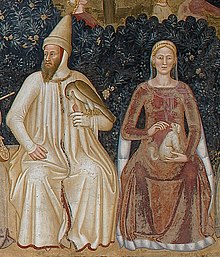
Albert IV of Austria (19 September 1377 – 14 September 1404) was a Duke of Austria.
He was born in Vienna, the son of Albert III of Austria and Beatrix of Nuremberg. He was the Duke of Austria from 1395 until 1404, which then included roughly today's Lower Austria and most of Upper Austria, as the other Habsburg dominions were at that time ruled by his relatives of the Leopoldinian Line of the family. Albert's rule was characterized by quarrels with that part of his family and with members of the Luxemburg dynasty, Wenceslaus and Sigismund.

Joanna Sophia of Bavaria (c. 1373 – 15 November 1410) was the youngest daughter of Albert I, Duke of Bavaria and his first wifeMargaret of Brieg. She was a member of the House of Wittelsbach.

William III (30 April 1425 – 17 September 1482), called the Brave (in German Wilhelm der Tapfere), was landgrave of Thuringia(from 1445) and claimant duke of Luxemburg (from 1457). He is actually the second William to rule Thuringia, and in Luxembourg; he was the third Margrave of Meissen named William. He was a younger son of Frederick I the Warlike, elector of Saxony, and Catherine of Brunswick and Lunenburg. On 2 June 1446 he married Anne of Luxembourg, daughter ofAlbert II, King of Germany, Bohemia and Hungary and Elisabeth of Luxembourg. On behalf of his wife, he became Duke of Luxembourg from 1457 to 1469. They had two daughters,Margaret of Thuringia (1449–1501) and Catherine of Thuringia (1453 – 10 July 1534), who married Duke Henry II of Münsterberg.
Anne of Bohemia and Austria (12 April 1432 – 13 November 1462) was a Duchess of Luxembourg in her own right, and as consort, Landgravine of Thuringia and of Saxony.
She was the eldest daughter of Albert of Austria, the future Emperor-Elect and Elisabeth, queen of Bohemia, the sole descendant of Sigismund, Holy Roman Emperor.
Ernst was founder of the Ernestine line of Saxon princes, and a direct patrilineal ancestor of Prince Albert of Saxe-Coburg and Gotha.
He was the second son (but fourth in order of birth) of the eight children of Frederick II, Elector of Saxony and Margaret of Austria, sister of Frederick III, Holy Roman Emperor.

Elisabeth of Bavaria-Munich (2 February 1443 in Munich – 5 March 1484 in Leipzig) was a princess of Bavaria-Munich by birth and by marriage Electress of Saxony.
Elizabeth was a daughter of the Duke Albert the Pious of Bavaria-Munich (1401–1460) from his marriage to Anna of Brunswick-Grubenhagen-Einbeck (1420–1474), daughter of the Duke Eric I of Brunswick-Grubenhagen.
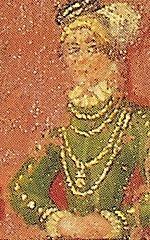
Louis III of Oława, mostly known as of Lüben (Polish: Ludwik III oławski or lubiński; before 1405 – before 18 June 1441), was a Duke of Oława (Ohlau) from 1419/20 and Duke of Lubin (Lüben) and Chojnów (Haynau) from 1431 until his death.
He was the third and youngest son of Henry IX, Duke of Lubin, by his wife Anna, daughter of Przemyslaus I Noszak, Duke of Cieszy
Margareta of Opole (Polish: Małgorzata opolska; c. 1412/14 – 15 January 1454), was a Polish princess. She was a member of the Opole branch of House of Piast and by marriage a Duchess of Oława-Lubin-Chojnów.
She was the daughter of Duke Bolko IV of Opole, by his wife Margareta, possibly a member of the House of Görz.
Louis II of Brieg; (1380/85 – 30 May 1436), was a Duke of Brzeg (Brieg) from 1399 (until 1400 with his older brother as a co-ruler) and Duke of Legnica from 1413.
He was the second son of Henry VIII with a Scar, Duke of Brzeg, but the eldest born by his second wife Margareta, daughter of Siemowit III, Duke of Masovia.
Elisabeth of Hohenzollern (Polish: Elżbieta Hohenzollern; 1 May/29 September 1403 – 31 October 1449), was a German princess member of the House of Hohenzollern and by her two marriages Duchess of Brzeg-Legnica and Cieszyn.
She was the eldest daughter of Frederick I, Elector of Brandenburg by his wife Elisabeth, daughter of Frederick, Duke of Bavaria-Landshut.
John, nicknamed the Alchemist (German: Johann der Alchimist; 1406 – 16 November 1464) was a Margrave of Brandenburg-Kulmbach and served as the peace-loving Margrave of Brandenburg after the abdication of his father, Frederick I, the first member of the House of Hohenzollern to rule Brandenburg.
John was the eldest son of Frederick I, Margrave of Brandenburg (1371–1440) and Elisabeth of Bavaria-Landshut (1383–1442), daughter of Frederick, Duke of Bavaria, and his second wife Maddalena Visconti.
William (German: Wilhelm) KG (c. 1392 – 1482), called the Victorious, was duke of Brunswick-Lüneburg. He is counted either asWilliam III or William IV.
William was the eldest son of Henry the Mild, Duke of Brunswick-Lüneburg. He inherited Lüneburg-Celle in 1416 and swapped it with his uncle Bernard I, Duke of Brunswick-Lüneburg, for Wolfenbüttel in 1428. While on a campaign in 1432, William was deposed by his brother Henry. William retained only the western part of Wolfenbüttel (to the west of the River Leine and separated from the rest by the Bishopric of Hildesheim), which was to become known as the Principality of Calenberg. After Henry died without son in 1473, William had control of both parts of Wolfenbüttel again.
Cecilia of Brandenburg (c. 1405 – 4 January 1449) was a princess of Brandenburg by birth and by marriage a Duchess ofBrunswick-Wolfenbüttel.
Cecilia was the daughter of Elector Frederick I of Brandenburg (1371–1440) from his marriage to Elizabeth (1383–1442), daughter of Duke Frederick of Bavaria-Landshut. Cecilia's brothers were the reigning Electors of Brandenburg, first Frederick II and later Albrecht III Achilles.
Count Bodo VII of Stolberg and Wernigerode (also known as Bodo the Elder; born: 1375; died: 15 March 1455 in Stolberg) was a German nobleman. He ruled the counties of Stolberg in the southern Harz and Wernigerode in the northern Harz.
Bodo was the son of Count Henry of Stolberg and Elizabeth née Countess of Hohenstein. Nothing is known about his youth. Perhaps he spent some time at a court of the Counts of Schwarzburg, possibly the one in the Sondershausen.
Anna, the daughter of Count Henry of Schwarzburg
Duke Wartislaw IX of Pomerania-Wolgast (c. 1400 – 17 April 1457, Wolgast) was the eldest son of the Duke Barnim VI, Duke of Pomerania and Veronica. Europaische Stammtafaln does not cite an origin for Veronica.[1]

Bogusław IX; (1407/1410 – 7 December 1446) was a duke of Pomerania in Pomerania-Stolp, whose residence was Stargard. His cousin Eric of Pomerania tried in vain to have him recognized as King of the Kalmar Union.
Bogusław was the son of Bogislaw VIII, Duke of Pomerania, and Sophia of Holstein. On June 24, 1432 in Poznan he married Maria of Masovia, daughter of Siemowit IV, Duke of Masovia and Alexandra of Lithuania.[1] They had daughters, Sophia, who marriedEric II, Duke of Pomerania, and Alexandra, and at least one of unknown name.[2
Maria of Masovia (pl: Maria mazowiecka; 1408/15 - 14 February 1454), was a Polish princess member of the House of Piast in the Masovian branch.
She was the sixth daughter of Siemowit IV, Duke of Masovia and Alexandra, a daughter of Algirdas, Grand Duke of Lithuania and sister of King Władysław II Jagiełło of Poland.
Eitel Friedrich II, Count of Hohenzollern (c. 1452 – 18 June 1512 in Trier) was a count of Hohenzollern and belonged to the Swabian line of the House of Hohenzollern. He was the first president of the Reichskammergericht. As a close friend of the Archduke and later Emperor Maximilian I, he gained great influence in the imperial politics. He managed to consolidate and expand his own territory.
Eitel Friedrich II was the son and heir of Count Jobst Nikolaus I (1433–1488). He continued his father's policy of good relationships with the Franconian line of the House of Hohenzollern, who ruled the Burgraviate of Nuremberg and the Margraviate of Brandenburg. During his father's reign, he spent several years at the court of Elector Albrecht Achilles. From 1481, he served as captain of the Lordship of Krosno Odrzańskie, east of the Oder. In 1483, he became a Councillor in Brandenburg. Later, he served as governor of Kottbus and Züllichau.

Magdalene of Brandenburg (1460 in Tangermünde – 17 June 1496 at Hohenzollern Castle) was a German noblewoman. She was a princess of Brandenburg by birth and by marriage a Duchess of Hohenzollern.
Magdalena was the only child of Margrave Frederick III of Brandenburg-Altmark (1424–1463) from his marriage to Agnes (1436–1512), daughter of the Duke Barnim VIII of Pomerania.

Christoph I of Baden (13 November 1453 – 19 April 1527) was the Margrave of Baden from 1475 to 1515.
Christoph was the eldest son of Karl I, Margrave of Baden-Baden and Catherine of Austria, a sister of Frederick III, Holy Roman Emperor. He built the New Castle and moved there in 1479. In 1515 he divided his possessions between his sons Bernhard, Philipp and Ernst. Thus, Bernhard founded the so-called "Bernardine line" of Baden-Baden and Ernst founded the "Ernestine line" of Baden-Durlach.

Ottilie of Katzenelnbogen (ca. 1451[1] – 15 August 1517, Baden-Baden), was by marriage Margravine of Baden-Baden. she was the only child of Philipp II the Younger of Katzenelnbogen (1427 – 27 February 1453) and Ottilie of Nassau-Dillenburg (April 1437 – July 1493). Her baptism took place one month after her father's death, on 22 March in Starkenburg Castle, nearDarmstadt.
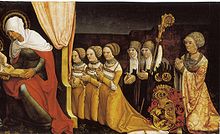
Frederick I of Ansbach and Bayreuth (also known as Frederick V; German: Friedrich II. von Brandenburg-Ansbach-Kulmbach orFriedrich der Ältere; 8 May 1460 – 4 April 1536) was born at Ansbach as the eldest son of Albert III, Margrave of Brandenburg by his second wife Anna, daughter of Frederick II, Elector of Saxony. His elder half-brother was the Elector Johann Cicero of Brandenburg. Friedrich succeeded his father as Margrave of Ansbach in 1486 and his younger brother as Margrave of Bayreuth in 1495.
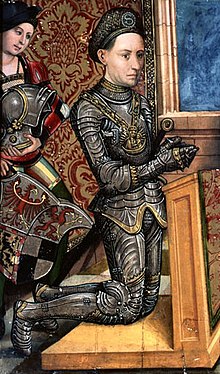
Sophia of Poland (Polish: Zofia Jagiellonka, 6 May 1464 – 5 October 1512), was a Polish princess member of the Jagiellonian dynasty and by marriage Margravine of Brandenburg-Ansbach and Brandenburg-Kulmbach.[1]
Born in Kraków, she was the second daughter of King Casimir IV of Poland of Poland and Archduchess Elisabeth of Austria. She was named after her paternal grandmother, Sophia of Halshany, Queen of Poland.

Diego Hurtado de Mendoza, 1. señor de Cañete
* c. 1380
Teresa Ramirez de Guzmán
* c. 1390
Alfonso Tenorio de Silva, señor de Barcience 1365 ijo de Aires Gomes da Silva, o Velho y Urraca Tenório
Guiomar de Meneses y Toledo o entre 1337 y 1397 ija de Gómez Suárez de Meneses y María de Toledo
Jacques Ier de Bade (Jakob I von Baden), né le 14 mars 1407 à Hachberg, décédé le 13 octobre 1453 à Mühlburg (de), est margrave de Bade de 1431 à 1453.
Jacques Ier de Bade est le fils de Bernard Ier de Bade et d’Anne d'Oettingen.
Dernière fille du duc Charles II de Lorraine et de Marguerite de Palatinat. Elle est la sœur cadette de la duchesse Isabelle Ire de Lorraine.
Gustav Sture, riddare och riksråd, född cirka 1410, död cirka 1444. Son till Anund Algotsson Sture och Christina Anundsdotter (Lejonansikte).
Birgitta Stensdotter (Bielke), död omkring 1462. Dotter till Sten Turesson (Bielke) och Margareta Karlsdotter (Sparre av Tofta). Syster till kung Karl Knutsson (Bonde), mor till riksföreståndaren Sten Sture den äldre, och farmors mor till kung Gustav Vasa.
Gift 1) med Gustav Anundsson Sture
Federico I di Hohenzollern (Norimberga, 21 settembre 1371 – Cadolzburg, 20 settembre 1440) fu l'ultimo burgravio di Norimberga col nome di Federico VI e principe elettore di Brandeburgo col nome di Federico I. Egli era figlio del burgravio Federico V di Norimberga e di Elisabetta di Meissen, e fu il primo membro della casata degli Hohenzollern a regnare sul Brandeburgo.

Elisabetta di Baviera-Landshut (1383 – Ansbach, 13 novembre 1442) fu una principessa bavarese e principessa consorte del Brandeburgo.
Era figlia di Federico di Baviera e di Maddalena Visconti, figlia di Bernabò Visconti, signore di Milano.
Guglielmo di Brunswick-Lüneburg, detto "il Vittorioso" (1392 – 1482), fu duca di Brunswick-Lüneburg. Viene anche indicato come Guglielmo III o, erroneamente, Guglielmo IV. Era il figlio maggiore di Enrico di Brunswick-Lüneburg e della prima moglie, Sofia di Pomeriana[1]. Ereditò il ducato Lüneburg-Celle nel 1416 e spodestò lo zio Bernardo I di Brunswick-Lüneburg dal principato di Wolfenbüttel nel 1428.
Cecilia di Hohenzollern (1405 – 4 gennaio 1449) fu una principessa del Brandeburgo e duchessa consorte di Brunswick-Lüneburg.
Era la seconda figlia di Federico I di Brandeburgo e di Elisabetta di Baviera-Landshut.
Giovanni I di Hohenzollern detto il Cicerone, (Ansbach, 2 agosto 1455 – Arneburg, 9 gennaio1499) fu Principe elettore di Brandeburgo (1486-1499). Alla propria morte ricevette l'appellativo diCicerone, derivante dall'oratore romano Cicerone, ma l'eloquenza dell'elettore e il suo interesse per le arti è stato oggi messo in discussione da recenti studi[1].
Giovanni era il figlio di Alberto III, e della sua prima moglie, Margherita di Baden. Nel 1466 successe allo zio, il principe elettore Federico II.

Margherita di Sassonia (Weimar, 1449 – Spandau, 13 luglio 1501) è stata una principessa di Sassonia ed elettrice di Brandeburgo..Margherita era una figlia del duca Guglielmo III di Sassonia (1425-1482) e di sua moglie Anna (1432-1462), figlia dell'imperatore del Sacro Romano Impero, Alberto II.

Alberto III di Brandeburgo, spesso conosciuto col nome di Alberto Achille (Tangermünde, 9 novembre1414 – Francoforte sull'Oder, 11 marzo 1486), della casata Hohenzollern, fu principe elettore diBrandeburgo e regnò anche sul principato di Ansbach. Ricevette il soprannome di Achilles per le sue riconosciute doti cavalleresche..
Era il terzo figlio maschio di Federico I ed Elisabetta di Baviera-Landshut e nacque a Tangermünde. Dopo aver passato alcuni anni alla corte dell'imperatore Sigismondo di Lussemburgo, prese parte alla guerra contro gli hussiti, e successivamente si distinse assistendo l'imperatoreAlberto II, contro la Polonia.

Anna di Sassonia (Meißen, 7 marzo 1437 – Neustadt an der Aisch, 31 ottobre 1512) è stata una principessa di Sassonia ed elettrice di Brandeburgo.
Era una figlia del principe elettore Federico II di Sassonia, e di sua moglie, Margherita d'Austria, figlia di Ernesto I d'Asburgo.

Casimiro IV Jagellone (pol.: Kazimierz IV Jagiellończyk - IPA:( ascolta) kaˈʑimi̯ɛʒ jaɡi̯ɛlˈlɔɲt͡ʃɨk; lituano: Kazimieras IV Jogailaitis) (1427 – 1492) re di Polonia dal 1447 al 1492 e granduca di Lituania, portò il Regno di Polonia a una posizione di predominanza nell'Europa orientale.
ascolta) kaˈʑimi̯ɛʒ jaɡi̯ɛlˈlɔɲt͡ʃɨk; lituano: Kazimieras IV Jogailaitis) (1427 – 1492) re di Polonia dal 1447 al 1492 e granduca di Lituania, portò il Regno di Polonia a una posizione di predominanza nell'Europa orientale.
La sua dinastia, quella degli Jagelloni, finì col governare molti stati.
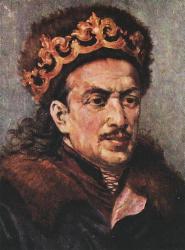
Elisabetta d'Asburgo, in polacco Elżbieta Rakuszanka (Vienna, 1437 circa – Cracovia, 30 agosto 1505), era figlia dell'imperatore Alberto II (1397 – 1439) e della di lui consorte Elisabetta di Lussemburgo (1409 c.a. – 1442).

John I, Duke of Cleves, Count of Mark (16 February 1419 – 5 September 1481) was Duke of Cleves and Count of Mark.
He was the son of Adolph I, Duke of Cleves and Mary of Burgundy. He was raised in Brussels at the Burgundian court of his unclePhilip the Good He ruled Cleves from 1448 from 1481, and Mark since 1461 after the death of his uncle Gerhard, who had waged war on his own brother

Elizabeth of Nevers (born: after 24 August 1439 in Nevers; died: 21 June 1483)[1] was Duchess of Cleves from 1455 until her death, due to her marriage with John I of Cleves-Mark. She is the matriarch of the house of Cleves-Nevers, and thus the Cleves line of the Counts and dukes of Nevers. Because the territory was part of her inheritance, it fell to her son Engelbert after her death.
Elizabeth was the oldest child of John II, Count of Étampes, Nevers, Rethel and Eu, and his first wife Jacqueline d'Ailly. Since Elizabeth's younger brother died at the age of five years and her father thus had no sons, he appointed his eldest daughter to the heir of the counties of Nevers and Eu.
.

Henry III, Landgrave of Upper Hesse, called "the Rich" (15 October 1440[1] – 13 January 1483) was the second son of Louis I of Hesse and his wife Anna of Saxony.
Anna, daughter and heir of Philipp, the last Count of Katzenelnbogen and his wife Anne of Württemberg.
Gerhard VII, Duke of Jülich-Berg (c. 1416 – 19 August 1475) was the son of William VIII of Jülich, Count of Ravensberg and Adelheid of Tecklenburg. Gerhard was the second duke of the combined Duchy of Jülich-Berg but the 7th Gerhard in the House of Jülich.[1]
Upon his father's death in 1428, Gerhard became Count of Ravensberg. In 1437, his uncle Adolf died without heirs and Gerhard inherited his title as Duke of Jülich-Berg. Gerhard continued his uncle's fight for the dukedom of Guelders, supported by King Albert II of Germany. In 1444 he won the Battle of Linnich but was unable to prevail in his fight for Guelders and ultimately sold his claim toBurgundy and acquired Blankenheim-Löwenberg and Heinsberg from Guelders. He was increasingly unable to govern his territories after 1461. His spouse Sophie of Saxe-Lauenburg then wielded regency for him.
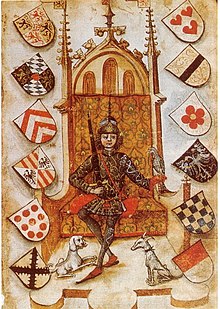
Sophie of Saxe-Lauenburg (born: before 1444; died: 9 September 1473) was a Duchess of Saxe-Lauenburg by birth and by marriage Duchess of Jülich-Berg. From 1456 until her death, she was regent of Jülich, Berg and Ravensberg for her eldest son.
Sophie was the daughter of Duke Bernard II of Saxe-Lauenburg († 1463) from his marriage to Adelheid (who died after 1445), a daughter the Duke Bogislaw VIII of Pomerania
Magnus II, Duke of Mecklenburg-Schwerin and Güstrow (1441 – 20 November 1503) was duke of Mecklenburg-Schwerin from 1477 until his death.
He was the son of Henry IV, Duke of Mecklenburg-Schwerin, and Dorothea of Brandenburg, daughter of Elector Frederick I of Brandenburg. Duke Henry IV had re-united the Mecklenburg lands under his rule through his inheritance of the former Lordships ofWerle and Stargard in 1436 and 1471, respectively. Near the end of his life, Henry IV devoted more and more time to hedonistic luxury, while Magnus and his brothers Albert and John took over the most active share in the business of government. John died in 1474 leaving a grieving widow, Sophie of Pomerania-Stettin, daughter of Duke Eric II of Pomerania, whom Magnus married himself in 1478.
:
Sophie of Pomerania-Stettin (c. 1460 – 26 April 1504, Wismar), was Duchess of Mecklenburg by marriage from 1478 to 1504.
She was the daughter of Eric II of Pomerania-Wolgast († 1474) and his wife Sophia of Pomerania-Stolp († 1497).
John II, "The Pious" or "The Babymaker", Duke of Cleves, Count of Mark, (German: Johann II. "der Pious" oder "der Kindermacher", Herzog von Kleve, Graf von Mark) (1458–1521) was a son of John I, Duke of Cleves and Elizabeth of Nevers. He ruled Cleves from 1481 to his death in 1521. He was called "The Babymaker" since he fathered sixty-three illegitimate children [1]before his marriage with Mathilde of Hesse in 1490. She was the daughter of Henry III, Landgrave of Upper Hesse and his wife Anna of Katzenelnbogen.[2]  Mathilde of Hesse (4 July 1473 in Blankenstein – 19 February 1505 in Cologne) was the daughter of Henry III, Landgrave of Upper Hesse (1441-1483) and his wife Anna of Katzenelnbogen (1443-1494).
William IV of Jülich-Berg (9 January 1455 – 6 September 1511) was the last ruler of the Duchy of Jülich-Berg.
William was the son of Gerhard VII, Duke of Jülich-Berg and Sophie of Saxe-Lauenburg. When his father died in 1475, William became Duke of Jülich-Berg.
Sibylle of Brandenburg (31 May 1467 in Ansbach – 9 July 1524 in Kaster) was a Princess of Brandenburg by birth and by marriage Duchess of Jülich and Duchess of Berg.
Sibylle was a daughter of Elector Albrecht III Achilles of Brandenburg (1414–1486) from his second marriage to Anna (1436–1512), daughter of the Elector Frederick II of Saxony.
Alexander of Zweibrücken (German: Pfalzgraf Alexander von Zweibrücken "der Hinkende") (26 November 1462 – 21 October 1514) was Count Palatine and Duke of Zweibrücken and of Veldenz in 1489–1514.
He was the son of Louis I, Count Palatine of Zweibrücken and his wife Johanna of Croÿ. Alexander promised to establish a church after the successful return from a crusade, and it was kept in 1489 with the building of the Alexanderskirche in Zweibrücken.
Countess Margarete of Hohenlohe-Neuenstein, daughter of Count Kraft VI of Hohenloheand Helene of Württemberg.
William I of Hesse (German: Wilhelm) (4 July 1466 – 8 February 1515) was the Landgrave of Hesse (Lower Hesse) from 1471 to 1493.
His parents were Louis the Frank (1438–1471) and Mechthild, daughter of Count Louis I of Württemberg. On 17 February 1488 inMünden, he married Anna of Brunswick-Wolfenbüttel c. 1460 - Worms 16 May 1520], daughter of William II, Duke of Brunswick-Wolfenbüttel and Elisabeth, Countess of Stolberg,
William II (29 April 1469 – 11 July 1509) was Landgrave of Lower Hesse from 1493 and Landgrave of Upper Hesse after the death of his cousin, William III, Landgrave of Upper Hesse in 1500.
William II is also called "William the Middle" to distinguish him from his elder brother "William I the Elder", and his cousin "William III, the Younger". His parents were Louis II the Frank (1438–1471) and Mechthild, daughter of Count Louis II of Württemberg.

Anna, Princess of Mecklenburg-Schwerin (14 September 1485, Plau am See[1] – 12 May 1525,[2] Rödelheim) was by marriage Landgravine of Hesse.
She was a daughter of Duke Magnus II of Mecklenburg (1441–1503), and Sophie of Pomerania-Stettin (about 1460 -1504). She was a member of the 13th Generation of the Princely House of Mecklenburg.
George the Bearded, Duke of Saxony (Meissen, 27 August 1471 – Dresden, 17 April 1539), was duke of Saxony from 1500 to 1539.
Duke George was a member of the Order of the Golden Fleece.
His father was Albert the Brave of Saxony, founder of the Albertine line of the Wettin family, his mother was Sidonie, daughter ofGeorge Podiebrad, King of Bohemia. Elector Frederick the Wise, a member of the Ernestine branch of the same family, known for his protection of Luther, was a cousin of Duke George.

Barbara Jagiellon (15 July 1478 – 15 February 1534[1]), was a Polish princess member of the Jagiellonian dynasty and by marriageDuchess of Saxony.
Born in Sandomierz, she was the sixth daughter of King Casimir IV of Poland of Poland and Archduchess Elisabeth of Austria. She was named after her great-grandmother, Barbara of Cilli, Holy Roman Empress.

William (German: Wilhelm) called William the Younger (German: Wilhelm der Jüngere, c. 1425 – 7 July 1503) was duke ofBrunswick-Lüneburg and ruled over the Wolfenbüttel and Göttingen principalities.
The eldest son of William the Victorious, Duke of Brunswick-Lüneburg, he was given the Principality of Göttingen by his father in 1473. In 1482 the father died, and he and his brother Frederick succeeded their father in the remaining parts of his state; however, William had Frederick imprisoned in 1484 and made himself sole ruler. In 1490 he bought the City of Helmstedt from the Abbott ofWerden. In 1491, William gave the Principality of Wolfenbüttel including Calenberg to his sons, and kept only Göttingen to himself. In 1495 he resigned as prince of Göttingen in favour of his son Eric I in return for an appanage. William died on 7 July 1503 inHardegsen.
Eric II or Erich II (between 1418 and 1425 – 5 July 1474) was a member of the House of Pomerania (also known as the House of Griffins) and was the ruling Duke of Duke of Pomerania-Wolgast from 1457 to 1474. He was the son of Wartislaw IX of Pomerania-Wolgast and Sophia, daughter of Eric IV of Saxe-Lauenburg.

Sophia of Pomerania-Stolp (1435 – 24 August 1497), was a Duchess of Pomerania by birth, and married to Eric II, Duke of Pomerania.
Sophia was the daughter of Bogislaw IX, Duke of Pomerania and Maria of Masovia. In 1446, her father died and was succeeded by his cousin, Eric of Pomerania, former King of Denmark, Norway and Sweden. Sophia became the heir of Eric of Pomerania's private fortune. In 1451, Sophia was married to Eric of Pomerania-Wolgast, making her spouse the heir of Eric of Pomerania's territories, while Sophia remained the heir of Eric of Pomerania's private fortune. At the death of Eric of Pomerania in 1459, Sophia's husband united Pomerania through the inheritance of Pomerania-Stolp and Pomerania-Rügenwalde by his marriage, while Sophia became the sole possessor of the vast fortune brought by Eric of Pomerania from his former kingdoms's in Scandinavia, as well as the one he had acquired by his piracy activity on Gotland.
Ulrich V of Württemberg called "der Vielgeliebte" (the much loved) (1413 – 1 September 1480, Leonberg), Count of Württemberg. He was the younger son of Count Eberhard IV and Henriette of Mömpelgard.
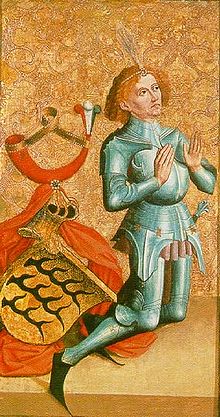
Christoph I of Baden (13 November 1453 – 19 April 1527) was the Margrave of Baden from 1475 to 1515.
Christoph was the eldest son of Karl I, Margrave of Baden-Baden and Catherine of Austria, a sister of Frederick III, Holy Roman Emperor. He built the New Castle and moved there in 1479. In 1515 he divided his possessions between his sons Bernhard, Philipp and Ernst. Thus, Bernhard founded the so-called "Bernardine line" of Baden-Baden and Ernst founded the "Ernestine line" ofBaden-Durlach.

Ottilie of Katzenelnbogen (ca. 1451[1] – 15 August 1517, Baden-Baden), was by marriage Margravine of Baden-Baden.
She was the only child of Philipp II the Younger of Katzenelnbogen (1427 – 27 February 1453) and Ottilie of Nassau-Dillenburg (April 1437 – July 1493). Her baptism took place one month after her father's death, on 22 March in Starkenburg Castle, near Darmstadt.
Philipp II the Younger was in turn the eldest of the two sons of Count Philipp I of Katzenelnbogen the Elder (1402 – 1479) and his first wife, Anna of Württemberg (1408 – 1471).
 Wolf von RosenfeldAnna Bombast von Hohenheim
Stephen of Simmern-Zweibrücken (German: Stefan Pfalzgraf von Simmern-Zweibrücken) (23 June 1385 – 14 February 1459,Simmern) was Count Palatine of Simmern and Zweibrücken from 1410 until his death in 1459.
He was the son of King Rupert of Germany and his wife Elisabeth of Nuremberg. After the death of Rupert the Palatinate was divided between four of his surviving sons. Louis III received the main part, John received Palatinate-Neumarkt, Stephen receivedPalatinate-Simmern and Otto received Palatinate-Mosbach.

Anne of Veldenz (c. 1390 – 18 November 1439 in Wachenheim) was a Countess suo jure of Veldenz. She was a member of theHohengeroldseck family, the second family to rule Veldenz.
Anna was the heiress of Frederick III, the last Count of Veldenz from the Hohengeroldseck family, and his wife Margaret of Nassau-Saarbrücken. In 1409, she married to Stephen, Count Palatine of Simmern-Zweibrücken, thereby bringing the County of Veldenz into the possession of the Dukes of Palatinate-Zweibrücken. She also brought a 50% share in the County of Sponheim into the marriage. The Counts of Veldenz had acquired this share in 1425, as had been predicted by Count John V of Sponheim-Starkenburg in the 1425 Treaty of Sponheim. Anna's eldest son Frederick I would inherit her share in the County of Sponheim, her son Louis I would inherit the County of Veldenz proper.
In the 19th century, a descendant of Anna became King of Bavaria, which is why the Veldenz lion is now part of the Bavarian coat of arms.

Antoine I de Croÿ (the Great), Seigneur de Croÿ, Renty and Le Roeulx, Count of Porcéan (around 1385 – September 21, 1475) was a member of the House of Croÿ.
Antoine was the eldest surviving son and heir of Jean I de Croÿ and Marie de Craon, and was a key figure in 15th-century French politics. In 1452, he secured for himself the post of Governor General of the Netherlands and Luxembourg[1] and presided over the pro-French party at the court of Philip the Good. He was also one of the judges at the trial for treason in 1458 of John II of Alençon.

Kraft V Count Of HOHENLOHE
Mother: Elisabeth Countess Of HANAU-MHUNZENBERG b: Abt 1390 in Of, Hanau, Hessen-Nassau, Prussia Mother: Eufemia Princess Of MHUNSTERBERG b: Abt 1370 in Of, Oppeln, Schlesien, Prussia 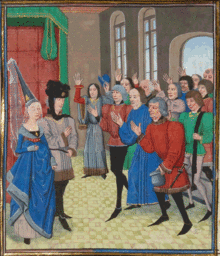
Joanna of Flanders (c. 1295 – September 1374) was Duchess of Brittany by her marriage to John of Montfort. Much of her life was taken up in defence of the rights of her husband and, later, son to the dukedom, which was challenged by the House of Blois during the War of the Breton Succession. Known for her fiery personality, Joanna led the Montfortist cause after her husband had been captured, and began the fight-back, showing considerable skill as a military leader.
In her later life, after the war had entered a stalemate, Joanna became mentally ill. She lived to see the final victory of her cause, but most of her last years she was cared for in England, confined at Tickhill Castle.
Joanna was highly praised by the chronicler Jean Froissart for her courage and energy. Because of her feats of leadership, David Hume described her as "the most extraordinary woman of the age".
Joanna was the daughter of Louis I, Count of Nevers and Joan, Countess of Rethel, and the sister of Louis I, Count of Flanders

Joan of Rethel (died 1328) was Countess of Rethel between 1285 and 1328.
She was the daughter of Hugh IV, Count of Rethel and his third wife Isabelle of Grandpré.
Felipe III de Navarra, (27 de marzo de 1306 – 16 de septiembre de 1343) También conocido como Felipe de Évreux o el Noble. Rey1 de Navarra, Conde de Évreux y de Longueville. Fue el tercer vástago y segundo varón de Luis de Évreux y deMargarita de Artois. A través de su padre era descendiente de San Luis de Francia, y a través de su madre, de Luis VIII de Francia.

Juana II de Navarra (Conflans, Francia, 28 de enero de 1311 — Bréval, 6 de octubre de 1349) fue Reina de Navarra entre 1328y 1349.
Juana nació en el castillo de Conflans, Francia, el 28 de enero de 1311, hija del rey Luis I de Navarra y X de Francia, llamado El Obstinado, y de su primera esposa, Margarita de Borgoña.

Juan II de Francia, llamado "el bueno" (en francés: Jean II le Bon) (Le Mans, 26 de abril de 1319 – Londres, 8 de abril de 1364), fue el segundo rey de Francia de la Casa de Valois. Era hijo de Felipe VI de Francia y Juana de Borgoña.

Bona de Luxemburgo nació con el nombre de Jutta (Judith), (Praga, Bohemia 20 de mayo de 1315 - 11 de septiembre de 1349) fue duquesa de Normandía, condesa de Anjou y de Maine. Ella fue la primera esposa del rey Juan II de Francia, sin embargo, ya que su muerte se produjo un año antes de la coronación, ella nunca fue reina consorte de Francia. Jutta se hizo conocida en la historia francesa como Bona de Luxemburgo.
Fue la hija del conde Juan I de Luxemburgo, Rey de Bohemia, y de su primera esposa Isabel de Bohemia. Fue la hermana del Sacro Emperador Romano Carlos IV, quien se coronó emperador seis años después de su muerte, en 1349. Sus abuelos maternos eran Wenceslao II de Bohemia y su primera esposa, Judit de Habsburgo. Sus abuelos paternos eran el emperador Enrique VII y su esposa Margarita de Brabante. Cuando Bona tenía unos quince años, su madre murió. Su padre decidió volver a casarse. Escogió como su novia a Beatriz de Borbón, reina de Bohemia. Tuvieron un hijo, Wenceslao, que sucedió a su padre en Luxemburgo.
Pedro I de Borbón (1311 - Poitiers; 19 de septiembre de 1356), noble francés, hijo de Luis I de Borbón y María de Henao.
A la muerte de su padre en 1342 recibió los títulos de conde de Clermont, conde de La Marche y fue nombrado segundo duque de Borbón.

Isabel de Valois nació en París en 1313 y murió en el mismo lugar el 26 de julio de 1383, siendo la hija del Carlos de Francia, conde de Valois, hijo del rey Felipe III, y de su tercera esposa, Mahaut de Châtillon-Saint Pol.

Esteban II de Baviera (1319 - 13 de mayo 1375, Landshut) (alemán: Stephan II mit der Hafte, Herzog von Bayern), después de 1347 fue duque de Baviera. Era el segundo hijo del emperador Luis IV de Baviera con su primera esposa Beatriz de Silesia y miembro de la Casa de Wittelsbach.

Bernabé Visconti, también llamado Bernabò o Barnabò (Milán, 1319 – Trezzo sull’Adda, 19 de diciembre de 1385), fue señor de Milán entre 1349 y 1385, junto a su tío Giovanni, sus hermanos Mateo y Galeazzo y su sobrino Gian Galeazzo. A Bernabé lo describen los historiadores contemporáneos como un gobernante muy cruel.
Nació en Milan, y fue hijo de Stefano Visconti y Valentina Doria. Entre 1346 y 1349 Bernabé estuvo en el exilio, hasta que pudo regresar gracias a su tío Giovanni, que decidió compartir el poder con los tres hijos de su hermano Stefano. En 1350 Bernabé se casó con Beatriz Della Scala, hija de Mastino II Della Scala señor de Verona, forjándose una alianza política y cultural entre las dos ciudades. Sus ambiciones y sus intrigas mantuvieron a Milán en una guerra constante contra el Papa Urbano V, Florencia, Venecia y Saboya. Con la muerte de su tío (1354) Bernabé se hizo cargo de la parte este del Señorío (Bérgamo, Brescia, Cremona yCrema), que lindaba con los territorios de Verona. Sus otros hermanos se hicieron con otras partes del territorio, mientras que Milán capital fue gobernada a turnos por los tres hermanos.

Walter Estuardo (c. 12961 2 - Castillo de Bathgate, 9 de abril de 13271 ) fue el sexto gran senescal de Escocia y padre del rey Roberto II de Escocia. Hijo de Jacobo Estuardo, gran senescal de Escocia y de Gilles (o Egidia) de Burgh, hija de Walter de Burgh, conde de Ulster
Edward III (13 November 1312 – 21 June 1377) was King of England from 25 January 1327 until his death; he is noted for his military success and for restoring royal authority after the disastrous reign of his father,Edward II. Edward III transformed the Kingdom of England into one of the most formidable military powers in Europe. His long reign of fifty years was the second longest in medieval England and saw vital developments in legislation and government—in particular the evolution of the English parliament—as well as the ravages of the Black Death.
Edward was crowned at age fourteen after his father was deposed by his mother and her lover Roger Mortimer. At age seventeen he led a successful coup against Mortimer, the de facto ruler of the country, and began his personal reign. After a successful campaign in Scotland he declared himself rightful heir to the French throne in 1337 but his claim was denied due to the Salic law. This started what would become known as theHundred Years' War.[1] Following some initial setbacks the war went exceptionally well for England; victories at Crécy and Poitiers led to the highly favourable Treaty of Brétigny. Edward's later years, however, were marked by international failure and domestic strife, largely as a result of his inactivity and poor health.
Edward III was a temperamental man but capable of unusual clemency. He was in many ways a conventional king whose main interest was warfare. Admired in his own time and for centuries after, Edward was denounced as an irresponsible adventurer by later Whig historians such as William Stubbs. This view has been challenged recently and modern historians credit him with some significant achievements.[2][3]
Edward was born at Windsor Castle on 13 November 1312, and was often referred to as Edward of Windsor in his early years.[4] The reign of his father, Edward II, was a particularly problematic period of English history.[5] One source of contention was the king's inactivity, and repeated failure, in the ongoing war with Scotland.[6] Another controversial issue was the king's exclusive patronage of a small group of royal favourites.[7]The birth of a male heir in 1312 temporarily improved Edward II's position in relation to the baronial opposition.[8] To bolster further the independent prestige of the young prince, the king had him created Earl of Chesterat only twelve days of age.[9]

Philippa of Hainault (24 June[1] 1314 – 15 August 1369) was Queen of England as the wife of King Edward III.[2] Edward, Duke of Guyenne, her future husband, promised in 1326 to marry her within the following two years.[3] She was married to Edward, first by proxy, when Edward dispatched the Bishop of Coventry "to marry her in his name" in Valenciennes (second city in importance of the county of Hainaut) in October 1327.[4] The marriage was celebrated formally in York Minster on 24 January 1328, some months after Edward's accession to the throne of England. In August 1328, he also fixed his wife's dower.[5]
Philippa acted as regent on several occasions when her husband was away from his kingdom and she often accompanied him on his expeditions to Scotland, France, and Flanders. Philippa won much popularity with the English people for her kindness and compassion, which were demonstrated in 1347 when she successfully persuaded King Edward to spare the lives of the Burghers of Calais. It was this popularity that helped maintain peace in England throughout Edward's long reign.[6] The eldest of her fourteen children was Edward, the Black Prince, who became a renowned military leader. Philippa died at the age of fifty-five from an illness closely related to dropsy. The Queen's College, Oxford was founded in her honour.
Philippa was born in Valenciennes in the County of Hainaut, in the Low Countries, a daughter of William I, Count of Hainaut, Holland and Zeeland, and Joan of Valois, the granddaughter of Philip III of France.[7] She was one of eight children and the second of five daughters. Her eldest sister Margaret married Emperor Louis IV in 1324; and in 1345, she became the suo jure Countess of Hainaut upon the death of their brother William in battle. William II, Count of Hainaut, nicknamed the Audacious, was also possessor of the counties of Zealand and Holland as well as of the seigniory of Frieze: these vacant inheritances were devolved to Margaret after agreement between Philippa and her sister.[8] Edward III of England, however, in 1364–65, in the name of his wife Philippa, demanded the return of Hainaut and other inheritances which had been given over to the Dukes of Bavaria–Straubing. He was not successful, as it was the custom in these regions to favour male heirs.[9]

Paon de Roet sometimes Payne Roet of Guienne (c.1310-1380), and also referred to as Sir Gilles de Roet, was a herald and knight from Hainaut who was involved in the early stages of the Hundred Years War. He became attached to the court of King Edward III of England through the king's marriage to Philippa of Hainaut.
He is most notable for the fact that he became the ancestor of the monarchs of England because his daughter Katherine married John of Gaunt. Her children, given the surname "Beaufort", became the forebears of the Tudor dynasty through Margaret Beaufort. Another of his daughters also made a notable marriage, to the poet Geoffrey Chaucer.
Paon de Roet was "probably christened as Gilles",[1] but seems to have been known as "Paon" or "Payne", Latinised as "Paganus". He is named in a legal document in the form Paganus de Rodio — referring to Rodium, the mediaeval Latin form corresponding to the Roeulx, or Le Rœulx, a town of 3000 inhabitants, 8 miles north-east of Mons, on the highway leading from Mons to Nivelle located in the County of Hainaut.
Paon de Roet may have been impelled to seek his fortune in England by the recital of the exploits of Fastre de Roet, who accompanied John of Beaumont in 1326, when, with three hundred followers, he went to assist the English against the Scots. Fastre was the younger brother of the last lord of Roeulx, descended from the Counts of Hainault. He and his brother Eustace fell into pecuniary straits, and were obliged to alienate their landed possessions. Fastre died in 1331, and was buried in the abbey church of Roeulx, while his brother Eustace survived till 1336. Paon was, like Fastre, a younger brother — possibly of a collateral line.
Thomas Holland, 1st Earl of Kent, 2nd Baron Holand, KG (c. 1314 – 26 December 1360) was an English nobleman and military commander during the Hundred Years' War.
He was from a gentry family in Upholland, Lancashire. He was a son of Robert de Holland, 1st Baron Holand and Maud la Zouche. One of his brothers was Otho Holand, who was also made a Knight of the Garter.
| |
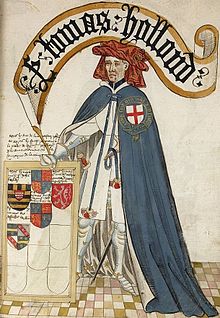

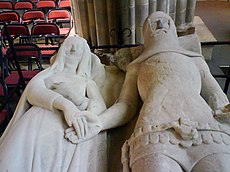


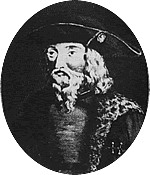
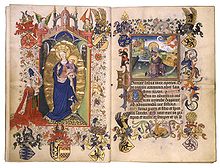
No hay comentarios:
Publicar un comentario